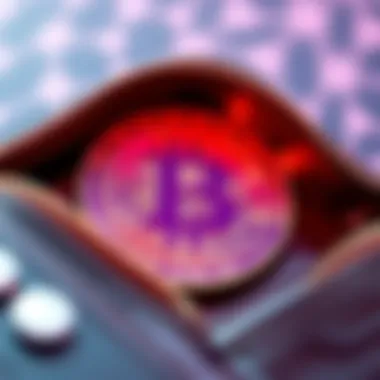Understanding NFT Ownership: Legal, Economic, and Social Aspects


Intro
In the constantly changing digital landscape, the emergence of non-fungible tokens (NFTs) has transformed how ownership is perceived, defined, and executed. This article aims to simplify and dissect the intricate world of NFTs, exploring the unique aspects of ownership that they introduce in the digital realm. As NFTs gain traction among investors, collectors, and tech enthusiasts alike, understanding their implications becomes not just valuable but essential.
Through this detailed examination, we will engage with vital areas such as the fundamental technology powering NFTs, the economic ramifications of their ownership, and the social dynamics that accompany this digital evolution. Let’s uncover the layers that form this fascinating web of digital assets, ensuring a thorough grasp of not just how NFTs operate, but why they matter.
Cryptocurrency Fundamentals
Understanding the framework within which NFTs operate is crucial. Blockchain technology forms the backbone of the cryptocurrency ecosystem, enabling secure, decentralized ownership of digital assets like NFTs.
Understanding Blockchain Technology
Blockchain can be seen as a public ledger, maintaining a record of transactions across multiple computers. This decentralized nature means that no single entity controls the transaction data, providing transparency and security. In the case of NFTs, the blockchain records transactions that verify ownership and provenance of the asset. Digital artists, for instance, utilize Ethereum-based platforms like OpenSea to tokenize their work, embedding unique identifiers that prevent copying or tampering.
The question of trust is also addressed here. Trust in traditional systems often relies on centralized authorities. Blockchain removes this reliance, establishing trust through cryptographic proofs, and allowing artists and collectors to interact directly, free of intermediary fees.
Key Concepts in Cryptocurrency Trading
While diving into NFTs, grasping certain trading concepts is key.
- Wallets: These act as digital safes for cryptocurrencies and NFTs, allowing users to store, send, and receive assets securely. Popular wallet options include MetaMask and Coinbase Wallet.
- Gas Fees: This term refers to the cost of processing transactions on the blockchain. It’s an important consideration when buying or selling NFTs, as these fees can fluctuate based on network congestion.
- Trading Platforms: Platforms like Rarible and Foundation are pivotal for NFT transactions, each offering unique features tailored to various types of users – from artists to investors.
Investing in NFTs requires understanding both the technical and market dimensions. You wouldn't go fishing without the right gear, would you?
Market Insights
As participation in the NFT marketplace rises, it is important to stay attuned to market influences and trends.
Current Trends in the Crypto Market
The NFT market has seen seismic shifts, influenced notably by celebrity endorsements, collaborations, and high-profile sales. NBA Top Shot, for instance, has captured sports fans by turning memorable highlights into purchasable moments, blurring lines between fandom and investment. Similarly, art sales have exploded, with pieces by artists like Beeple fetching tens of millions at auction.
Analyzing Market Movements and Predictions
To successfully navigate this terrain, investors must analyze market movements. Key metrics include:
- Volume of Sales: Tracking the total number of NFTs sold can offer insights into market health.
- Floor Price: This indicates the lowest price at which an NFT in a collection is listed. A rising floor price often signals growing interest or perceived value.
- Market Sentiment: Sentiment can fluctuate based on news cycles, regulatory discussions, and technological advancements.
Predicting future movements involves combining historical data, market trends, and investment sentiments. Resources like CoinMarketCap or nonfungible.com provide valuable insights and statistics, aiding in informed decision-making.
Each segment of the NFT journey—from understanding blockchain fundamentals to analyzing market insights—equips readers with the tools necessary to grasp the complicated world of NFT ownership. By synthesizing these components, potential investors and collectors will be better prepared to make informed decisions in an evolving landscape.
For those eager to delve deeper, you might want to explore resources like Wikipedia, Britannica, and forums such as Reddit that discuss current trends and future possibilities within the NFT space.
Prolusion to NFTs and Ownership
In today’s digital landscape, the conversation around ownership is evolving at a dizzying pace, driven largely by the emergence of non-fungible tokens, or NFTs. These digital assets have disrupted traditional notions of ownership, introducing a unique framework that blends creativity, technology, and investment potential. As NFT ownership continues to gain traction across various sectors—including art, music, and gaming—the importance of understanding its mechanics cannot be overstated.
NFTs offer users a chance to own one-of-a-kind digital items, fundamentally altering the way we perceive and transact ownership in the online realm. This section will explore crucial elements surrounding NFTs and their ownership, looking into the benefits they confer, the considerations that accompany them, and the underlying intricacies that make them tick. Engaging with NFTs isn't merely about purchasing digital art; it's about entering a community, participating in a market, and sometimes even shaping culture.
The Value of NFT Ownership
The value of owning an NFT manifests in several ways:
- Scarcity: Each NFT is unique or part of a limited series, thus providing a sense of scarcity that traditional digital assets lack.
- Authenticity: With the blockchain serving as a public ledger, owners have a way to prove authenticity, which is crucial in markets like art where forgeries present significant challenges.
- Collectibility: Just like physical collectibles, NFTs possess a cultural currency that can appreciate over time, often influenced by trends and communal desires.
"Owning an NFT is akin to having a physical piece of art in a gallery; it’s not just the material but the status that comes with it that amplifies its value.”
However, the appeal of NFTs as a form of ownership also comes with deep considerations. Investors must remain keenly aware of factors such as market volatility, technological dependencies, and the evolving legal landscape that could impact the way NFTs are viewed and utilized in terms of ownership rights.
Defining Non-Fungible Tokens
At the heart of this discussion lies the definition of non-fungible tokens. Unlike cryptocurrencies like Bitcoin or Ethereum that are interchangeable—each unit is the same as any other—NFTs are distinctly unique. An NFT can be visualized as a digital certificate tied to an object, validating that specific ownership to the holder. This tokenization allows digital creators to monetize their work while providing buyers a means of proving authenticity.


NFTs can encapsulate various forms of digital content. For instance, a digital painting, a video clip, or even a tweet can be minted as an NFT, thus bestowing it with ownership rights under the blockchain system. The key distinction between fungible and non-fungible assets reflects directly on ownership. While you might trade one Ethereum for another and retain the same value, an NFT for a famous meme or collectible holds its own data and value, making it irreplaceable. This characteristic is crucial in appreciating the significance of NFT ownership.
The Concept of Digital Ownership
Understanding digital ownership in the context of NFTs requires revisiting traditional concepts of property rights and the implications of digital transactions. Digital ownership diverges from physical ownership since it encompasses not only the rights to use but also to transfer and sell the digital asset.
Transformative as it is, digital ownership raises fundamental questions: How does one define ownership when the asset can be replicated infinitely? NFTs provide a framework where ownership is traceable, transparent, and securely locked on a blockchain, resolving some of these ambiguities. This opens doors to a new dimension in how individuals interact with and value digital content.
In this landscape, content creators stand to gain unprecedented control over their work, enabling them to directly engage with consumers while leveraging the potential for profit. This shift empowers artists and innovators, positioning them as critical players in the ongoing dialogue about ownership in the digital world.
The Mechanics of NFT Ownership
The mechanics of NFT ownership are pivotal in understanding the implications of non-fungible tokens in the digital space. As NFTs gain traction among art collectors, gamers, and investors, grasping the underlying processes becomes essential. This section breaks down the intricacies of NFTs, from their creation to the technology that supports them, and how ownership is defined and maintained within this framework.
How NFTs Are Created and Minted
Creating and minting NFTs isn't as straightforward as just clicking a button; it involves a series of steps that ensure digital assets are unique and traceable. The core steps include:
- Selection of Content: Begin with the digital item—be it art, music, video, or even virtual real estate.
- Minting Process: During minting, the content is created as a token on the blockchain. This involves transforming the digital file into a blockchain entity using specific standards like ERC-721 or ERC-1155, common in Ethereum networks.
- Uploading Metadata: Add crucial details about the NFT, including ownership history and links to the original content. This metadata is stored on-chain or off-chain, depending on the strategy employed by the creator.
- Connecting to a Wallet: The newly minted NFT is linked to a digital wallet, ensuring the owner possesses control and can manage the asset.
Minting is often facilitated through platforms such as OpenSea, Rarible, or Foundation, making the process accessible even for those less tech-savvy. However, artists must be wary of the costs involved, as gas fees can add up significantly on certain networks. Thus, understanding how to create an NFT effectively is crucial for ensuring that the effort aligns with potential value.
Understanding Blockchain Technology
At the heart of NFTs lies blockchain technology, a decentralized ledger that records transactions across multiple computers. Its importance for NFT ownership cannot be overstated, as it provides
- Security: The immutable nature of blockchain ensures that once data is recorded, it cannot be altered or tampered with. This safeguards ownership rights.
- Transparency: Each transaction related to an NFT is publicly available, allowing the ownership history to be easily traced by anyone. This transparency fosters trust among buyers and sellers.
- Decentralization: No single entity controls the blockchain, reducing the risk of manipulation or fraud.
Through these attributes, blockchain technology supports the authenticity of NFTs, making it harder for counterfeit versions to emerge. Understanding this technology not only benefits investors but also creators and users within the space.
Ownership Records and Smart Contracts
One of the standout features of NFTs is the role of smart contracts in governing their ownership. A smart contract is a self-executing contract with the terms of the agreement directly written into code.
- Ownership Verification: Smart contracts automatically validate ownership, ensuring that the current holder is indeed the rightful owner without the need for intermediaries.
- Transfer Mechanics: When an NFT is bought or sold, smart contracts facilitate the transfer process seamlessly. They ensure that all parties fulfill their obligations before the trade is finalized.
- Royalties and Resale: Creators can embed royalty arrangements within the smart contract, allowing them to earn a percentage every time their work is resold. This innovative aspect significantly enhances the economic sustainability of creators in the digital age.
In summary, smart contracts ensure that ownership records are crisp, clear, and automatically maintained. They add an extra layer of trust and efficiency that traditional ownership frameworks often lack. Leveraging these technologies is key for anyone looking to navigate the complexities of NFT ownership.
In the rapidly evolving world of NFTs, understanding the mechanisms of creation, the underlying technology, and ownership management is paramount for investors and creators alike.
As NFT ownership builds momentum, comprehending these mechanics ensures that responsible engagement with digital assets can lead to fruitful outcomes.
Legal Dimensions of NFT Ownership
Understanding the legal dimensions surrounding NFT ownership is crucial for anyone engaging in this burgeoning area. The implications of NFTs extend beyond the digital asset itself; they enter a complex realm of intellectual property rights, contract law, and regulatory frameworks that can significantly affect buyers, sellers, and creators alike. This section will explore the fundamental aspects of NFT ownership through its legal lenses, shedding light on potential pitfalls and opportunities in this dynamic environment.
Intellectual Property Issues
Intellectual property (IP) rights form the backbone of legal discussions on NFTs. Each digital asset's uniqueness implies a connection to a specific creator or brand, which introduces various IP considerations. When individuals buy an NFT, they often have a misconception regarding what ownership entails. More often than not, purchasing an NFT does not grant the buyer full rights over the underlying content. Instead, buyers typically acquire ownership of the token itself, not necessarily the copyright or reproduction rights associated with the digital work. This misunderstanding can lead to disputes and potential legal issues.
For instance, a piece of digital art sold as an NFT remains under the original artist's copyright unless explicit rights have been transferred. Buyers looking to profit by repurposing the artwork could find themselves facing legal action if they fail to grasp this distinction.
Here are some significant points to consider regarding intellectual property in the NFT realm:
- Copyright Ownership: Always confirm whether the NFT transfer includes rights to republish or modify the underlying content.
- Moral Rights: Artists may retain moral rights regardless of ownership transfer, affecting how their work can be displayed or used.
- Third-Party Claims: Ensure there are no existing claims on the digital asset before completing the purchase.
By keeping these aspects in mind, potential buyers can navigate the complex world of IP and make informed decisions when entering the NFT space.
Regulatory Considerations
As NFTs grow in popularity, regulators worldwide are taking notice. Legal frameworks governing digital assets are still evolving, causing uncertainty for investors. Regulatory considerations are influenced by how NFTs are classified—whether they are seen purely as collectibles, securities, or something entirely different.
In many jurisdictions, the classification of NFTs could impact everything from taxation to consumer protection. For example, if an NFT is deemed a security, it falls under stricter regulations from agencies like the U.S. Securities and Exchange Commission (SEC). This can involve requirements regarding registration, transparency measures, and compliance with existing securities laws.


Here are a few regulatory concerns to keep an eye on:
- Tax Implications: Profits made from selling NFTs may be considered capital gains, necessitating accurate reporting.
- Consumer Protection: Potential buyers must ensure that platforms adhere to regulations designed to protect them from fraud.
- Cross-Jurisdictional Issues: The internet transcends borders, making it tricky for regulators to enforce rules across different countries.
Keeping abreast of these developments is vital for participants in the NFT space. Engaging with legal advisors knowledgeable in digital assets can help ensure compliance while minimizing risks.
"Navigating the legal landscape of NFTs is like walking a tightrope; a single misstep can lead to a fall into intricate legal battles."
In summary, understanding the legal landscape of NFT ownership is crucial. Grasping the nuances of intellectual property issues and regulatory considerations helps stakeholders make wiser informed decisions, reducing the risk of future complications.
Economic Perspectives on NFT Ownership
The realm of non-fungible tokens (NFTs) presents a unique economic landscape that merges traditional concepts of ownership with the digital age. Understanding the economic perspectives surrounding NFT ownership is crucial for several reasons. Firstly, the dynamics of supply and demand govern the pricing of NFTs, often leading to significant price fluctuations and market volatility. Additionally, grasping investment strategies in this new territory can empower stakeholders to navigate risks while capitalizing on opportunities in a rapidly evolving marketplace.
Market Dynamics and Pricing
In the NFT market, pricing is not merely dictated by the cost of creation or minting. Instead, it is heavily influenced by various factors such as market trends, rarity, artist reputation, and collector sentiment. The uniqueness of each token can sometimes lead to inflated prices, as buyers may perceive value differently based on emotional investment or cultural significance.
To explore this further:
- Rarity: Many NFTs have limited editions or one-of-a-kind features, making them highly desirable. The more scarce the item, the higher the demand might be.
- Artist Reputation: Well-known creators can command higher prices for their work, as buyers often equate the fame of the artist with value.
- Cultural Relevance: NFTs tied to significant events or movements may spike in price as collectors seek to own a piece of history.
"In an increasingly digital economy, the rarity and provenance of NFTs can turn into real financial assets, reshaping how we think about ownership."
Market dynamics in the NFT space often resemble that of regular art markets but are magnified by the digital element. Speculative investments can lead to bubbles, where prices swell unexpectedly before a sudden drop. Hence, staying informed about trends is essential for participants in this arena, especially potential investors.
Investment Strategies in NFTs
Investing in NFTs can be as intricate as discerning fine art or cryptocurrency. Potential investors should adopt several strategies to guard against risks while maximizing potential returns. Here are a few key strategies:
- Diversification: Just like with traditional investments, spreading your portfolio across various NFTs can mitigate risks. Engaging with pieces from different artists, genres, and blockchain platforms can balance the exposure to market fluctuations.
- Research: Understanding valuation metrics is essential. Analyzing historical sales data, following influential figures and trends in the NFT space, and participating in community discussions can inform better purchasing decisions.
- Long-Term Holding: While quick-flipping might seem enticing, many investors find value by holding onto certain NFTs for an extended period, especially if they believe in the underlying project or artist.
Investors should also maintain a critical view of the market's speculative nature. Buying an NFT isn’t solely about its aesthetic or social value; often, it is an investment in an idea or a community.
Social Implications of NFT Ownership
The advent of non-fungible tokens (NFTs) has stirred conversations that reach far beyond mere digital collectibles. Exploring the social implications of NFT ownership reveals how these tokens are reshaping communities, redefining relationships between creators and consumers, and giving rise to a new cultural phenomenon. The impact of NFTs goes beyond transactions; it touches on the very fabric of how we interact, express, and value digital art and assets.
Community and Culture in the NFT Space
The NFT space has blossomed into a vibrant community where like-minded individuals gather to appreciate and invest in digital art. Unlike traditional marketplaces, which often feel impersonal, NFT platforms create a unique forum where individuals can connect over shared interests in art, technology, and investment.
- Shared Enthusiasm: Individuals in the NFT community often share a passion for creativity and innovation. This have led to increased collaborations between artists and collectors, enhancing the cultural fabric of digital art.
- Collective Identity: Through platforms like Discord and Twitter, NFT collectors often develop a unique identity tied to the projects they support, fostering a sense of belonging.
- Even Generosity: Many within these communities engage in charitable activities, supporting artists or donating proceeds from NFT sales to causes they believe in.
The cultural implications of NFTs extend to how we perceive ownership. Traditionally, owning a physical piece of art provided not just aesthetic pleasure but also status. With NFTs, ownership can become a badge of identity in the digital realm, redefining what it means to possess something valuable in a non-physical space.
The Role of Artists and Creators
NFTs have drastically reshaped the role of artists in the digital ecosystem, allowing them to gain direct access to their audience while bypassing traditional gatekeepers like galleries and auction houses. It's not just about selling art; it’s about establishing genuine relationships with supporters.
- New Revenue Streams: Artists are no longer limited to selling physical copies. They can sell unique digital works, earn royalties on secondary sales, and even engage in community discussions.
- Ownership Return: NFTs provide artists with greater control over their work. They can enforce rights and track the ownership history of their creations, something that was often lost in traditional art markets.
- Empowerment Through Visibility: Emerging artists can gain recognition in a global marketplace, allowing unique voices that may not have been heard to rise.
As artists navigate this uncharted territory, they often face the challenges of market volatility, speculation, and the pressure to continually create. However, the potential for recognition and the ability to foster deep connections with their audience can outweigh these hurdles.
"NFTs are not just a trend; they are a new canvas for cultural expression."
Challenges and Risks in NFT Ownership
Navigating the world of non-fungible tokens (NFTs) comes with its own set of rewards and pitfalls. As the digital asset space continues to burgeon, so too do the challenges and risks that potential investors and collectors face. Understanding these nuances is crucial for anyone looking to engage in NFT ownership. This section sheds light on critical aspects such as security concerns and the nature of market volatility.
Security Concerns and Fraud Risks
In the NFT arena, security is not just a buzzword—it's a fundamental component that demands attention. Ownership of NFTs hinges on blockchain technology, which is often perceived as secure due to its decentralized nature. Yet, the reality is more complex. Vulnerabilities do exist within this system. For example, users can fall prey to phishing scams where counterfeit websites impersonate legitimate NFT marketplaces to steal digital assets.


Furthermore, wallet security is paramount. A poorly secured digital wallet can easily become a target for hackers. Here are some key points to consider:
- Phishing Attacks: Always verify URL authenticity. Scammers often create fake marketplaces.
- Private Key Exposure: Losing access to your wallet or sharing your private key can lead to irreversible losses.
- Rug Pulls: In a rug pull, developers abandon a project after extracting funds from investors. These can also appear legitimate at first glance.
Given the charismatic rise of NFTs, fraudsters are inevitably drawn to the space. Staying informed is your best defense against these risks. Integrating security measures, such as enabling two-factor authentication and regularly updating passwords, can significantly mitigate the chances of falling victim to fraud.
The responsibility for securing NFTs ultimately lies with the owner. Being proactive is key to protecting investments in this digital frontier.
Market Volatility and Speculation
Market dynamics in the NFT space resemble a roller coaster ride—unpredictable, exhilarating, and sometimes downright risky. The value of NFTs can fluctuate wildly, influenced by trends, celebrity endorsements, and community sentiment. For instance, a piece from a previously unknown artist can skyrocket in value after a few tweets from a prominent influencer.
This volatility is both a boon and a bane:
- Opportunities for Profit: Savvy investors can ride the wave of speculation and sell their assets at a premium.
- Risk of Loss: Conversely, if the market dips, one can easily find themselves holding onto a digital asset that has plummeted in value.
To navigate this turbulent landscape, potential investors should consider:
- Research: Understanding the project behind the NFT is crucial—it’s not just art; it might represent a community or a cause.
- Diversification: Just like in traditional investing, spreading investments across various NFTs can cushion against market downturns.
- Long-term Perspective: Not every NFT will deliver immediate returns. Sometimes, holding an asset for an extended period can yield better results than quick flips.
As the market continues to mature, balancing between excitement and caution is essential for those involved in NFT ownership. Recognizing these challenges can lead to more informed and strategic decisions.
Future Trends in NFT Ownership
The landscape of non-fungible tokens, or NFTs, is as dynamic as a chameleon at a paint factory. As we look ahead, it's imperative to consider the pivotal trends shaping NFT ownership. These trends not only influence how we interact with digital assets but also showcase the potential for innovation and acceptance in mainstream markets.
Technological Innovations and Evolution
To grasp the future, one must first understand the ongoing technological innovations in the NFT space. Speaking plainly, technology is a driving force behind NFT's transformative potential. For instance, advancements in blockchain technology are paving the way for greater scalability and faster transactions. For example, Layer 2 solutions like Optimism and Arbitrum are enhancing the speed and efficiency of transactions, meaning collectors can trade NFTs with fewer delays and lower costs.
Moreover, we are witnessing the rise of interoperability between various blockchain networks. Imagine holding an NFT and being able to utilize it across multiple platforms, from gaming to virtual galleries. Such capabilities would broaden the utility of NFTs beyond mere collectibles, making them a core component of the digital economy.
To add another layer, artificial intelligence is also making its mark. With AI-generated art gaining traction, the idea of ownership is evolving. Artists could create unique pieces using AI technology, being able to sell their work as NFTs while retaining certain rights – this blurs the lines between human creativity and machine learning.
"NFTs represent a new chapter in ownership that’s rooted in technology, offering a playground for creators and collectors alike."
Potential for Mainstream Adoption
When it comes to mainstream adoption of NFTs, the potential is immense yet riddled with challenges. For the average Joe or Jane, the concept of owning a digital asset might still seem a bit foreign. However, initiatives aimed at educating the public can play a pivotal role in changing this perception. As awareness increases, so does the likelihood of everyday individuals engaging with NFTs.
Looking at successes in sectors such as gaming and sports, we see that people are eager to own digital collectibles. Companies like NBA Top Shot have successfully tapped into fan engagement by offering limited edition moments of highlight plays, allowing fans to not only collect but also trade. This suggests that when people see a practical application, the adoption curve steepens.
Furthermore, brands across different industries are beginning to embrace NFTs as part of their marketing strategies. Think of fashion brands like Prada launching NFT collections, or the Gucci NFT artwork that made headlines. This shows that NFTs are entering retail spaces not just in niche collections but as an accepted form of branding.
The End and Final Thoughts on NFT Ownership
As we reach the close of this exploration into NFT ownership, it's clear that this topic holds a significance that extends far beyond mere digital collectibles. Understanding NFTs reshapes our perspectives on ownership itself, especially in a world increasingly defined by digital assets. The implications of NFT ownership are vast, bearing consequences for creators, collectors, investors, and the very fabric of our digital interactions.
The nuances of legal rights and obligations, economic models, and social interactions found in this digital sphere reveal layers of complexity that can be hard to grasp at first. However, breaking these elements down offers several benefits. First and foremost, it equips potential investors with knowledge. Armed with an understanding of the legal landscape, they are better prepared to navigate potential pitfalls and make informed decisions.
Moreover, analyzing the market dynamics, including the volatility and speculation inherent to NFTs, empowers both seasoned traders and newcomers alike to identify opportunities and risks. By grasping the foundation of NFT technology, one can appreciate how ownership records are maintained, giving further credence to the concept of digital ownership.
In a nutshell, exploring NFT ownership encourages critical thinking about ownership in the digital era. Traditional notions of possession are becoming increasingly blurred, and it's essential to stay ahead of the curve as these trends evolve.
Summarizing Key Insights
In summarizing the key insights from our discourse, here are the primary takeaways:
- Understanding NFTs: The nature of non-fungible tokens diverges sharply from classical assets. They represent unique ownership of digital content, whether it be art, music, or virtual real estate.
- Legal Framework: A solid comprehension of the legal landscape around NFTs is indispensable. Intellectual property matters, alongside regulatory guidelines, present both challenges and opportunities in this domain.
- Market Behavior: NFT values can fluctuate dramatically due to market dynamics. Investors should recognize the forces at play to better strategize their engagements in this space.
- Community Engagement: The social aspects of NFT ownership foster community ties among creators and collectors, enhancing the overall experience beyond mere transactions.
- Future Considerations: The evolution of NFTs hints at potential future ownership models that may diverge significantly from current practices, requiring ongoing vigilance and adaptability.
Implications for Future Ownership Models
The future of ownership models within the context of NFTs is both exciting and uncertain. As digital assets continue to morph and integrate into our daily lives, several implications emerge:
- Legacy of Ownership: The concept of generational ownership may change. NFTs allow for unique transferability options, suggesting a new way to inherit digital assets alongside traditional ones.
- Expanded Utility: With innovative technological advancements, NFTs may evolve to incorporate practical functionalities beyond simple ownership, like access to exclusive services or events.
- Community-Centric Models: Engaging ownership structures that invite community members to co-create or co-own assets could redefine traditional ownership paradigms, shifting focus from individual possession to collective stewardship.
- Increased Regulation: As the NFT market matures, we might see more comprehensive regulations take shape, potentially standardizing practices and protecting all parties involved.
- Global Collaboration: NFTs could lead to a more global approach to ownership, breaking down geographical barriers by allowing creators and collectors from diverse backgrounds to interact on a shared platform.
As we can see, the journey of NFT ownership is just beginning. Investors, creators, and enthusiasts must remember that being informed is key in a world characterized by rapid change. Engaging with these insights can lead to more thoughtful, meaningful exchanges in the burgeoning marketplace of digital assets.
"Owning a piece of the digital realm is not just about possession; it's about understanding the very nature of what ownership means today and tomorrow."
For those interested in learning more, resources available at Wikipedia or Britannica can provide deeper insights into this complex yet fascinating topic.



